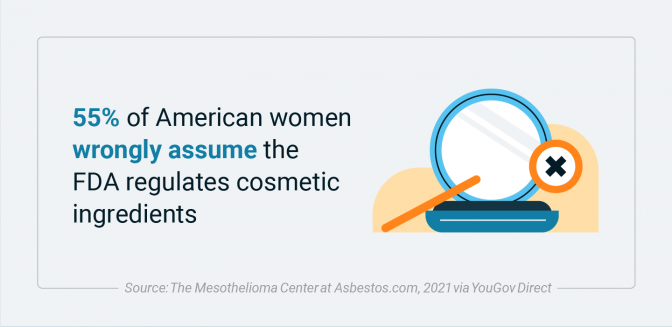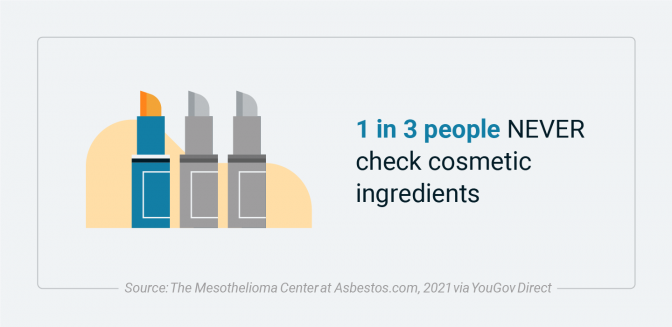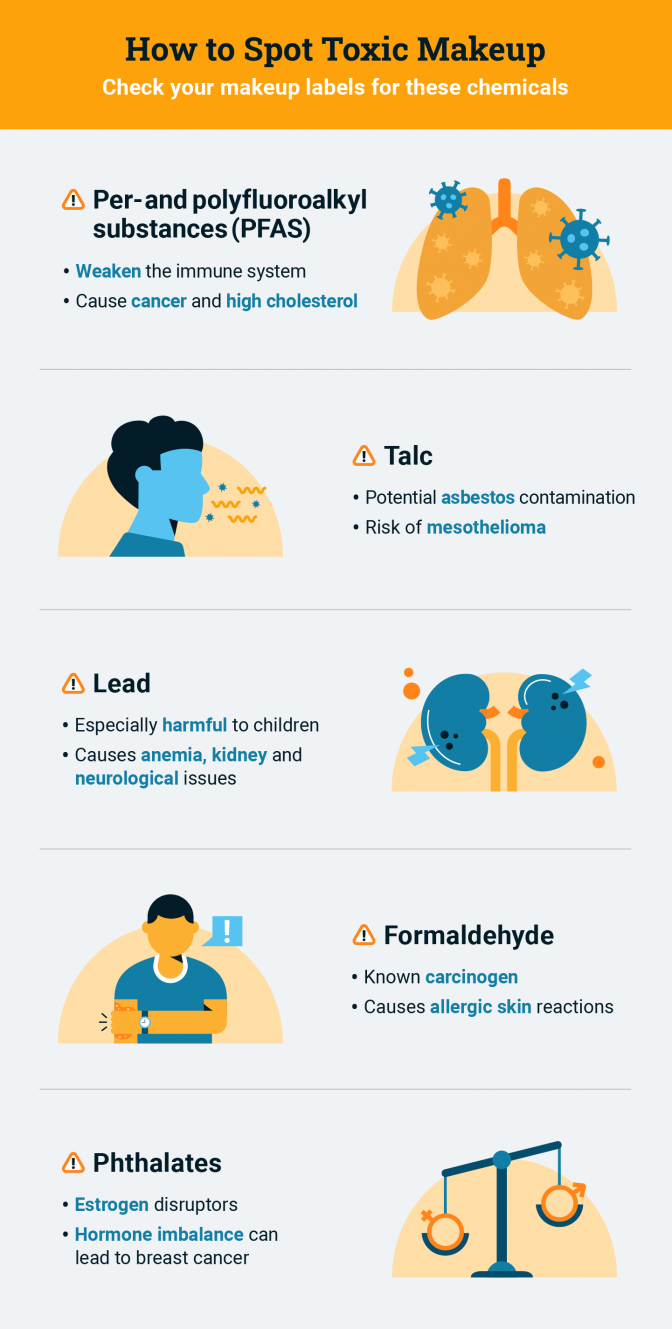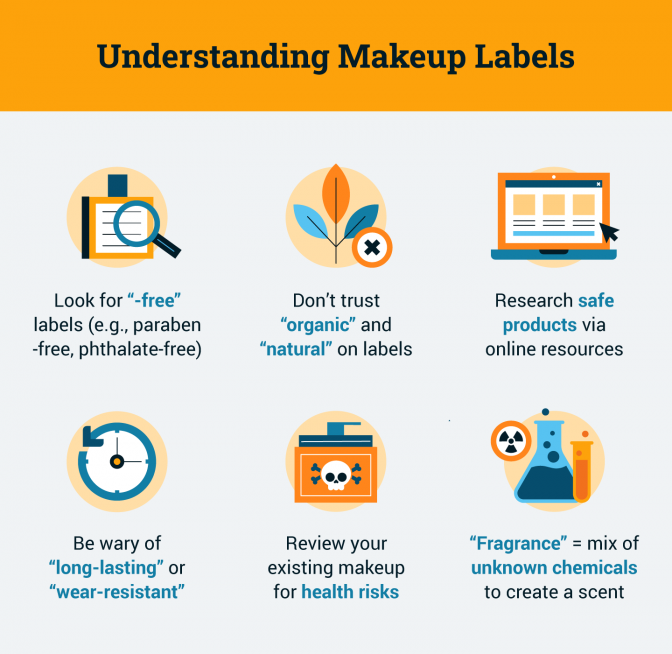What Is Some Harmful Things That Makeup
45% of People Worry About Toxic Makeup — Should You?
The U.S. Food and Drug Administration is responsible for making sure that food, drugs and other consumer products — including cosmetics — are safe. But you lot may be surprised to learn that they practise not actively regulate the contents of corrective products sold in the United States. Therefore, the makeup you wearable may contain chemic ingredients that could be harmful to your health.
Common contaminants found in cosmetics range from lead and asbestos to phthalates and more. They can be found in lipstick, powders, fragrances, nail polish, lotions and other beauty products. The health risks associated with this dangerous list of hidden ingredients include cancer, fertility bug, hormone imbalance and neurological problems, to proper noun just a few.
We surveyed i,000 Americans to gauge their business organization and knowledge of toxic risks from makeup products. Cardinal findings reveal:
- 45% of people are concerned almost the potential dangers of unregulated cosmetics.
- 55% of American women wrongly assume the FDA regulates cosmetic ingredients.
- one in 3 people NEVER check cosmetic ingredients.
- 46% of frequent makeup-wearers proactively review cosmetic ingredients before making a buy.
In this post, we explore the results and provide useful tips on how to identify safer makeup options.
Majority of Women Unaware of FDA Makeup Regulations

Americans trust the FDA to oversee the safety of products they use every twenty-four hours, including cosmetics. Equally our survey shows, that trust has led 55% of female person respondents to wrongly presume that the system regulates makeup ingredients. And 59% of men fabricated the same mistaken assumption.
The FDA has been regulating the cosmetics industry since the 1930s, but it has created no substantial guidelines manufacturers must follow. As clarified past the FDA, "The law does not require corrective products and ingredients, other than color additives, to have FDA approval before they go on the market." In contrast to the FDA's more detailed oversight of nutrient and drug products, cosmetic manufacturers are non required to share their product formulas or even register with the FDA. They are left to regulate themselves.
Compared to the rest of the world, U.S. regulations of chemicals and contaminants in makeup products are drastically limited. An analysis past the Environmental Working Group (EWG) identified more than xl nations that take adult specific and strict regulations for the ingredients of cosmetics and personal intendance products. Some have restricted or completely banned more than than 1,400 chemicals from use in cosmetics. The FDA has also taken similar measures to ban and restrict such chemicals for prophylactic reasons — but only for a total of nine chemicals.
Can Toxic Chemicals in Makeup Really Hurt Me?
How much of an impact can hidden chemicals in makeup actually take on your wellness? For many years, studies have shown that pare absorbs corrective chemicals, allowing them to enter the bloodstream. Pulverisation makeup products may be inhaled, bringing potential contaminants such as asbestos into the airway and lungs. Lip makeup may also be ingested by repeatedly licking or biting your lips, delivering the chemicals to your stomach and digestive organization.
The corporeality of exposure to any harmful chemical is a central cistron in its potential impact on your health. For frequent makeup-wearers, daily use of a variety of products leads to chronic exposure over many years.
Health Risks from Makeup
Due to the broad spectrum of contaminants that may be nowadays across a wide diversity of makeup products, the list of potential resulting wellness issues is long. Some common health concerns connected to toxic cosmetics include:
- Cancers, such as chest cancer and malignant mesothelioma
- Fertility issues and birth defects
- Neurological issues
- Hormone imbalances
- Asthma
- Thyroid issues
The risks of developing serious health bug such as these must be weighed confronting the level of trust you take in the manufacturers of your preferred makeup products.
33% Never Check the Ingredients in Makeup

Many people examine the labels of their food products, or what goes in their bodies, before making a purchase. But, according to our survey results, i in three people never look at the ingredients of new cosmetics, or what goes on their bodies. When nosotros break that response down past gender, the numbers shift to xx% of women and 49% of men who never examine makeup labels.
Unsurprisingly, frequent makeup-wearers are the most proactive, with 46% in the addiction of reviewing cosmetic ingredients before making a purchase. Knowing what to wait for — even for the biggest makeup lover — is not easy or straightforward.
How to Spot Toxic Makeup

One of the biggest obstacles in deciphering the dangers lurking in a makeup label is that non all of the potentially harmful ingredients are really listed.
For instance, contempo research uncovered that more than half of the pop cosmetic products they tested contained meaning evidence of per- and polyfluoroalkyl substances (PFAS), which are used to increase durability and water resistance in makeup. Almost none of the PFAS-heavy products included the chemicals on their ingredients labels. PFAS are known to crusade multiple health issues, such every bit cancer, high cholesterol and weakened immune systems.
One common makeup ingredient you lot may see on labels simply mistakenly assume holds no risk is talc. Ofttimes added to cosmetics to aid blot moisture, talc tin can be perfectly safe. But dangers arise from the possible contamination of talc with asbestos, a microscopic cancer-causing natural cobweb that can practice severe damage to your lungs. Talc and asbestos are natural minerals that often grade close together geologically, resulting in the need for all talc deposits to be tested for asbestos. If manufacturers skip that step, consumers risk developing asbestos-related cancers such equally mesothelioma.
Pb is a harmful heavy metal and naturally occurring impurity that can show upwardly in lipstick and any eye products containing kohl. High levels of lead can crusade serious anemia, neurological problems and kidney problems in children. Even low-level pb exposure has been shown to cause learning and behavior problems. The ingredients of cosmetic products marketed to children should be examined closely.
Another carcinogenic ingredient often found in beauty products is formaldehyde. Ofttimes used in nail polish, nail glue and eyelash glue, the chemical has been completely banned from cosmetics in Nippon and Sweden.
Additional chemical contaminants to look for on cosmetic labels include:
- Triclosan: Frequently found in body wash and toothpaste
- Phthalates: Often found in nail polish, fragrances and hairspray
- Parabens: Often used in moisturizers and soaps
- Toluene: Often found in nail shine
- Carbon Black: Often institute in mascara, lipstick and eyeliner
How to Identify Toxic vs. Safe Makeup Products

Deciphering the ingredients list on your cosmetics is no easy feat. The chemical names tin be disruptive, as manufacturers often identify certain chemicals by alternating names. Use these tips to ameliorate your odds of finding safe makeup products.
Don't Trust Makeup Labels
Sure phrases on beauty products should not be trusted. The terms "natural" and "organic" practice non guarantee a production has no toxic ingredients and there is no legal standing to verify their accuracy. Also be mindful that products labelled "long-lasting" or "wear-resistant" may incorporate PFAS, which are chemicals known to cause serious health bug.
Trustworthy Resource for Safe Makeup
Multiple organizations dedicated to making makeup safer for everyone have created valuable online and in-app databases that tin help you decipher the health dangers hidden in your cosmetics' ingredients. Many also provide recommendations for nontoxic makeup products.
- Skin Deep Cosmetics Database
- Features information on more than 74,000 products from the scientists at EWG
- Entrada for Safe Cosmetics
- Created by Breast Cancer Prevention Partners
- Retailer Report Card: Who'south Minding the Store?
- Research the actions of your favorite stores on issues of toxic chemicals in their products
- INCIDecoder
- Search past products or ingredients to observe the full details on all ingredients and their alternative names
Wearing makeup is a daily practice for many Americans, withal so many presume the cosmetics they employ each day are safe. Being mindful of the potential dangers of toxic makeup, especially during regular cancer screenings, can make a difference in achieving a healthy hereafter.

Methodology:
The survey featured in this post was conducted on YouGov Direct. One thou U.S. adults ages 18 and older were surveyed on Aug. eleven, between xi a.m. and v:32 p.m. Eastern time. Data is weighted based on age, gender, education level, political amalgamation and ethnicity to be nationally representative of adults 18 and older in the United States. The margin of mistake is approximately 4.5% for the overall sample.
Source: https://www.asbestos.com/featured-stories/makeup-toxicity-survey/
Posted by: dorseyfrialking.blogspot.com

0 Response to "What Is Some Harmful Things That Makeup"
Post a Comment